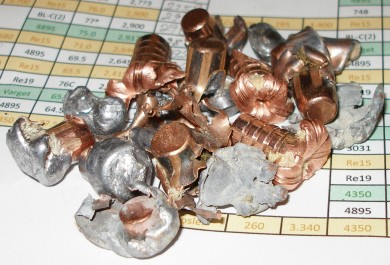
As you can see, I’ve been busy; lots of noise and chronograph tipping muzzle blast, the acrid odor of smokeless powder constantly in the air, big rounds and hard kicking rifles. The 375 H&H produced some very respectable numbers, clearly a cartridge that can always live up to its reputation. The 375 Ruger out shot calculated performance by a wide margin in anything 300 grains or less, suggesting a higher than typical case efficiency. Two very different guns representing two different points in time.
Some useful equipment….
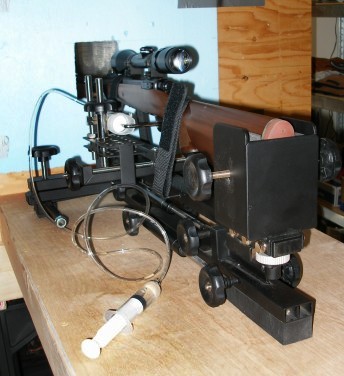
The boom box is alive and well and took lots of shots from the 375 Ruger and H&H project rifles while suppressing muzzle blast, pressure waves and maintaining neighborhood friendships. The interior of the box held up fine, as did the exterior, however, duct tape was called in to secure the rear foam panel when it blew out from pressure. The rear panel alone is responsible for almost 10dB in noise reduction.
Because of the comparatively heavy recoil and large quantity of rounds tested, both rifles were fired from a HySkore “Dangerous Game” machine rest with a remote trigger. I had tried a sled product, but it had to be loaded up with lots of weight, it wasn’t very precise or flexible in adjustment and remote fire feature wasn’t available. The HySkore equipment is engineered to be light at 22 lbs and fully adjustable; cant, windage, elevation front-rear, and degree of recoil absorption. Dead weight is not added, it relies on a compact fluid shock absorber to damped recoil and return the gun to battery. The product is packaged with a selection of three shock absorbers that cover recoil ranges 3 – 20 ft/lbs, 20-50 ft/lbs and 50-85 ft/lbs; anything from the 223 Remington to the 416 Rigby. I used the mid range during this project which seemed to work well. A firearm can be discharged manually, however, the remote fire hydraulic system kept me 10 feet from the gun and out of harm’s way, which is appropriate while developing loads for a cartridge that lacks a lot of history. The rest’s instructions suggest it can produce 3 MOA repeatability in shot placement with remote fire, I think it is closer to 2 MOA or better, in some cases. I did not use the rest for accuracy testing, however, I used it only for chronograph work and ops checking each firearm. The cost is about $200 at retailers, only $10 more than a Caldwell Lead Sled DFT, and it is a useful equipment addition. I will do a detailed write up when I get a little more time.
The Rifles…
The rifles were both on their best behavior. The CZ 550 barely showed a temperature rise in relatively quickly fired strings. 6 heavily charged rounds, fired inside of two minutes, resulted in less than 105°F peak reading on the Fluke thermometer. The hottest point along the barrel was just aft of the rear sight, about the location of the chamber throat. Ambient at the time was 84°F and relative humidity 58%. The Ruger was pretty much the same, which was more of a surprise because the gun isn’t as beefy with as much surface area to radiate off heat. If this had been one of my short belted magnum rifles, I would have been able to use the barrel to make toast. If it had been one of my 378 based Weatherby rifles, I would have been able to grill a couple of nice steaks.
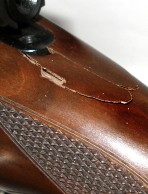 My favorite hog’s back stock gave it up after about 30 rounds while being shot without the rest. The stock didn’t actually fracture as much as it spit out a couple of divots at the tang, so I went ahead and finished the live fire portion without any apparent ill effects, including accuracy. The stock fracture was my fault, an expensive lesson in inletting. It is great to have a tight fit between barreled action and stock, but the action tang shouldn’t be a primary point of impact under recoil. When I trimmed the front under barrel recoil lug to better fit the barrel to the barrel channel, I also reduced the shock being absorbed by the lug and transferred it to other recoil surfaces. I’m sure I will be thinking about this when I fit the replacement stock.
My favorite hog’s back stock gave it up after about 30 rounds while being shot without the rest. The stock didn’t actually fracture as much as it spit out a couple of divots at the tang, so I went ahead and finished the live fire portion without any apparent ill effects, including accuracy. The stock fracture was my fault, an expensive lesson in inletting. It is great to have a tight fit between barreled action and stock, but the action tang shouldn’t be a primary point of impact under recoil. When I trimmed the front under barrel recoil lug to better fit the barrel to the barrel channel, I also reduced the shock being absorbed by the lug and transferred it to other recoil surfaces. I’m sure I will be thinking about this when I fit the replacement stock.
The CZ action felt rough compared to the Ruger after a while, but nothing drastic. Rotating lock up was smooth, the roughness was in bolt travel while feeding a cartridge from the mag. When I find the source I will update. The Ruger got more slick with use and the bolt felt like it was sliding on bearings. It’s stock did not split or crack or chip or peel, but then I hadn’t attempted to add my own “improvements”. I still can’t get over how small Ruger rifle is for a cartridge of this power and how well behaved it is in recoil and handling. The detail of both guns was covered more extensively in earlier articles on Real Guns. Both guns were accurate, the mid range bullet weights more so, the extreme light and heavy still better than good. For hunting shots fired, or a typical box of ammo range outing, neither was abusive to shoot and scope mount systems proved to be reliable.
Range Conditions

The weather was moderate, ranging from 71°F to 82°F, humidity ran from 78% to heavy rainfall intermissions, with a high probability of turkeys. My wife loves this gaggling, seed eating, homely birds and I keep imagining them feet up in a roasting pan with a “I told you I was going to get you” note pinned to their featherless chest. This little gathering began 15 minutes after I paused shooting during a downpour and it looked as though their intent was to play flag football. I had to chase them out of the yard and down a woods path we call Turkey Highway so I could resume shooting. I felt like Rodney Dangerfield…but wait until next May. More to the point, no temperature extremes, but the rainy weather was for the birds.
Bullets and explosive knock down power…
 Something to think about. Handguns with 300 ft/lbs – 600 ft/lbs of kinetic energy are frequently attributed with the power to knock over assailants. High power rifles, the big guns, are often rolled into tales of knocking cape buffalo off their feet as a result of devastating knockdown power. During data collection, I stood a dry birch log on end in the middle of a plastic five gallon bucket and filled the bucket’s remaining empty space with dry sand, then placed the bucket in front of the backstop. I fired one of each bullet type into the bucket, some with over 5,000 ft/lbs of energy. Not only did they not pass through the bucket, they didn’t even get the pail to barf sand on impact, or move the pail on the ladder it was sitting on, or even disturb the log in the sand for that matter.
Something to think about. Handguns with 300 ft/lbs – 600 ft/lbs of kinetic energy are frequently attributed with the power to knock over assailants. High power rifles, the big guns, are often rolled into tales of knocking cape buffalo off their feet as a result of devastating knockdown power. During data collection, I stood a dry birch log on end in the middle of a plastic five gallon bucket and filled the bucket’s remaining empty space with dry sand, then placed the bucket in front of the backstop. I fired one of each bullet type into the bucket, some with over 5,000 ft/lbs of energy. Not only did they not pass through the bucket, they didn’t even get the pail to barf sand on impact, or move the pail on the ladder it was sitting on, or even disturb the log in the sand for that matter.
I could understand if the bullets passed through and expended their energy on the backstop rather than the bucket. I assume the lack of contact shock could mean the small frontal area of the bullet couldn’t transfer the bullet’s energy to the material and the lack of moisture in the sand removed the effects of pressure waves or hydraulic reaction from fluid displacement. Perhaps the appearance of shock on a target is very much dependent on the bullet forcing uncompressible fluid out of its path and shock waves multiplying the effect ? I’ve done quite a bit of hunting over the years and most animals hit drop immediately, or after taking a handful of steps. It seems there is typically massive damage to vital organs, usually heart/lung, and heavy internal bleeding. What’s my point? Not a point so much as an open question. What is the importance of kinetic energy, regardless how it is expressed, if it has no proportional impact on the target ? I guess the degree of bullet momentum is really an expression of potential penetration, with actual penetration and wound channel severity bullet design dependent. What is the advantage of these 5000 ft/lbs of energy generating 375s over a 300 Winchester Magnum if not to knock a bear on it’s butt? Like the piece of straw that blows through a cement wall during a tornado, these big bullets will pass through more soft tissue, muscle and bone and leave a larger diameter wound channel than their smaller cousins. To achieve this benefit, bullet selection is critical.
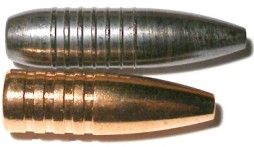 The GS Custom and Barnes Triple Shock bullets provided the most consistent performance; expanded down to the first 25%-30% of their length producing a frontal diameter between 0.688″ and 0.872″, depending on how symmetrical the expansion, and they did this when contacting almost anything that was placed in front of the target. They also held onto an incredible 92% to 95% of their original weight. I’ve heard people express concern over bullets passing through game. I guess I would have to ask, “So what?”. The internal damage has been done, as long as expansion has occurred and the bullet’s path is through a vital area. The additional ventilation makes for a faster bleed out. The GS slug is flat out fast, thanks to its unique design, and it puts a lot less wear and tear on equipment. The Barnes bullet was prone to showing signs of excessive pressure at modest load levels. The very light Hornady and Speer bullets used during this project did not perform well at these load levels. Best I could find in slug recovery were some odd lead fragments and jacket chard. In all fairness, neither manufacturers suggests their respective products are suitable for this type of application with other than light loads and significantly lower velocities for deer hunting.
The GS Custom and Barnes Triple Shock bullets provided the most consistent performance; expanded down to the first 25%-30% of their length producing a frontal diameter between 0.688″ and 0.872″, depending on how symmetrical the expansion, and they did this when contacting almost anything that was placed in front of the target. They also held onto an incredible 92% to 95% of their original weight. I’ve heard people express concern over bullets passing through game. I guess I would have to ask, “So what?”. The internal damage has been done, as long as expansion has occurred and the bullet’s path is through a vital area. The additional ventilation makes for a faster bleed out. The GS slug is flat out fast, thanks to its unique design, and it puts a lot less wear and tear on equipment. The Barnes bullet was prone to showing signs of excessive pressure at modest load levels. The very light Hornady and Speer bullets used during this project did not perform well at these load levels. Best I could find in slug recovery were some odd lead fragments and jacket chard. In all fairness, neither manufacturers suggests their respective products are suitable for this type of application with other than light loads and significantly lower velocities for deer hunting.
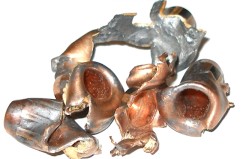 The Nosler AccuBond 260 grain and Sierra GameMaster 300 grain bullets went 60% producing perfectly mushroomed 70% – 85% retained weight recovered slugs, then 40% leaving nothing more than a nicely expanded, but very empty jacket. The slow moving Woodleigh Protected Point 350 grain slugs, which were only traveling 2,400 fps at the muzzle, all ended up with only the shank intact and the rest of the bullet lost with the exception of torn jacket material. Retained weight was on the order of 30%. I think the results, for me, lead me to the conclusion that solid material bullets would be optimal, followed by a partition type bullet. There were too many jacket shedding failures and loss of too much retained weight to make me want to go with a one piece jacket product, bonded or not. As I noted, I will leave final conclusions to further and more appropriate and controlled testing.
The Nosler AccuBond 260 grain and Sierra GameMaster 300 grain bullets went 60% producing perfectly mushroomed 70% – 85% retained weight recovered slugs, then 40% leaving nothing more than a nicely expanded, but very empty jacket. The slow moving Woodleigh Protected Point 350 grain slugs, which were only traveling 2,400 fps at the muzzle, all ended up with only the shank intact and the rest of the bullet lost with the exception of torn jacket material. Retained weight was on the order of 30%. I think the results, for me, lead me to the conclusion that solid material bullets would be optimal, followed by a partition type bullet. There were too many jacket shedding failures and loss of too much retained weight to make me want to go with a one piece jacket product, bonded or not. As I noted, I will leave final conclusions to further and more appropriate and controlled testing.
Comparative Velocity Performance
| Bullet | Mfg # | Weight | 375 H&H | 375 Ruger | ||||
| Calculated Velocity | Actual Velocity | Calculated Velocity | Actual Velocity | Velocity Gain* | Energy Gain Ft/lbs | |||
| Hornady | 3706 | 225 | 3,066 | 3,084 | 3,052 | 3,206 | +122 | 383 |
| Speer | 2471 | 235 | 3,022 | 3,115 | 2,996 | 3,195 | +80 | 263 |
| Barnes | 37552 | 235 | 3,014 | 3,103 | 2,987 | 3,177 | +74 | 242 |
| Nosler | 54413 | 260 | 2,834 | 2,804 | 2,831 | 2,955 | +151 | 502 |
| GS Custom | 2657 | 265 | 2,917 | 2,986 | 2,897 | 3,054 | +68 | 242 |
| Sierra | 3000 | 300 | 2,646 | 2,736 | 2,678 | 2,810 | +74 | 273 |
| Woodleigh | W46C | 350 | 2,489 | 2,405 | 2,493 | 2,481 | +76 | 289 |
| *Ruger Hawkeye African with 23″ barrel. CZ 550 Safari with 25″ barrel | ||||||||
There is a two inch barrel difference between the two guns, or actually 1.680″ after adjusting for the difference in cartridge length. 2.000″ or 1.680″, I do not believe this differential should be a significant factor in comparing these two cartridges (i.e. “Who knows how the 375 Ruger would have performed with a longer barrel?”. The efficient 375 Ruger, with its high completion of powder burn, might not gain much from an additional 2″ of barrel length. As I’ve noted before, I do not believe the most important benefit of this cartridge is in it’s performance over the 375 H&H, as it is in meeting and somewhat exceeding the performance of the 375 H&H in a much more manageable firearm, of lighter weight and with a standard action length.
The 375 Ruger has serious potential. WSMs and SAUM rounds suffer from restrictive COL that pushes long bullets back into the case and robs powder capacity, in comparison to the 30-06 length belted magnums they are intended to replace. The 375 Ruger does not have such a problem. Instead it delivers full length 375 H&H ballistics and then some, across the bullet weight range. That GS Custom bullet load is practically a varmint load at 3,000+ feet per second. To place this in perspective, with a 3″ critical kill zone, this load offers a 233 yard point blank range with a rise and fall along the bullet path of no more than 1.5″. At 300 yards the bullet drop is only 6″ and it is still carrying 3747 ft/lbs of kinetic energy. Power is relative, but this one is still carrying a ton at 800 yards.
Handload Results and Data
The tables that follow do not represent all of the project’s handloads, bullets or powder tested, but they do represent the best results in velocity, pressure and accuracy. I will eventually update and merge the H&H data with data already appearing in the handload section and go back and review some of the 375 Ruger loads not included here to see if they fair better the second time around. The data included within this installment represents heavy loads. I don’t think much, if anything, was left on the table in squeezing out performance. If you use the data for reference, I strongly suggest backing off a couple of percentage points and working up or down from there as your own rifle, equipment and climate warrant. GS Custom bullet data specifically accommodates the unique design of this bullet and would be absolutely hazardous in concert with products of same or similar weight from other manufacturers. Because of the very thin driving bands and undersize shank, the GS bullet offers extremely low yield resistance when it contacts rifling, so an increased charge is required to create optimal start pressure.
| Handload Data – 375 H&H | ||||||||||
| Bullet Type | Bullet Weight |
Bullet Diameter |
C.O.L. | Net Water Capacity |
Powder Type |
Charge | Primer Type |
Muzzle Velocity |
Muzzle Energy |
Group Size |
| Hornady SPFB 3706 | 225 | .375″ | 3.555″ | 83.8 | Reloder 15 | 78.0 | CCI 250 | 2935 | 4305 | 1.5 |
| Hornady SPFB 3706 | 225 | .375″ | 3.555″ | 83.8 | Varget | 77.5 | CCI 250 | 3054 | 4661 | 0.9 |
| Hornady SPFB 3706 | 225 | .375″ | 3.555″ | 83.8 | IMR 4895 | 76.5 | CCI 250 | 3084 | 4753 | 0.9 |
| Hornady SPFB 3706 | 225 | .375″ | 3.555″ | 83.8 | IMR 3031 | 73.0 | CCI 250 | 3069 | 4707 | 1.3 |
| Speer SPFB 2471 | 235 | .375″ | 3.600″ | 86.7 | Reloder 15 | 79.0 | CCI 250 | 2970 | 4604 | 0.6 |
| Speer SPFB 2471 | 235 | .375″ | 3.600″ | 86.7 | Varget | 79.0 | CCI 250 | 3089 | 4980 | 0.8 |
| Speer SPFB 2471 | 235 | .375″ | 3.600″ | 86.7 | IMR 4895 | 77.5 | CCI 250 | 3115 | 5065 | 1.0 |
| Speer SPFB 2471 | 235 | .375″ | 3.600″ | 86.7 | IMR 3031 | 73.5 | CCI 250 | 3020 | 4760 | 1.2 |
| Barnes TSXFB 37552 | 235 | .375″ | 3.700″ | 83.6 | Reloder 15 | 76.5 | CCI 250 | 2963 | 4582 | 1.2 |
| Barnes TSXFB 37552 | 235 | .375″ | 3.700″ | 83.6 | Win 748 | 75.5 | CCI 250 | 3039 | 4820 | 1.2 |
| Barnes TSXFB 37552 | 235 | .375″ | 3.700″ | 83.6 | IMR 4895 | 75.0 | CCI 250 | 3103 | 5026 | 1.5 |
| Nosler SPBT 54413 | 260 | .375″ | 3.600″ | 77.8 | Reloder 15 | 71.5 | CCI 250 | 2745 | 4351 | 0.8 |
| Nosler SPBT 54413 | 260 | .375″ | 3.600″ | 77.8 | Varget | 71.0 | CCI 250 | 2788 | 4489 | 1.1 |
| Nosler SPBT 54413 | 260 | .375″ | 3.600″ | 77.8 | IMR 4895 | 70.5 | CCI 250 | 2804 | 4540 | 0.6 |
| Nosler SPBT 54413 | 260 | .375″ | 3.600″ | 77.8 | IMR 3031 | 67.0 | CCI 250 | 2758 | 4393 | 1.3 |
| GS Custom HVBT 2657 | 265 | .375″ | 3.700″ | 80.2 | Reloder 15 | 76.0 | CCI 250 | 2930 | 5053 | 1.2 |
| GS Custom HVBT 2657 | 265 | .375″ | 3.700″ | 80.2 | BL-C(2) | 77.0 | CCI 250 | 2986 | 5248 | 0.9 |
| GS Custom HVBT 2657 | 265 | .375″ | 3.700″ | 80.2 | IMR 4895 | 75.0 | CCI 250 | 2980 | 5227 | 0.7 |
| Sierra SPBT 3000 | 300 | .375 | 3.680″ | 81.0 | Reloder 15 | 71.0 | CCI 250 | 2693 | 4832 | 0.9 |
| Sierra SPBT 3000 | 300 | .375 | 3.680″ | 81.0 | IMR 4895 | 69.5 | CCI 250 | 2736 | 4988 | 0.7 |
| Woodleigh PPFB W46C | 350 | .375″ | 3.600″ | 76.7 | Reloder 15 | 65.5 | CCI 250 | 2361 | 4333 | 1.1 |
| Woodleigh PPFB W46C | 350 | .375″ | 3.600″ | 76.7 | Reloder 19 | 76.0 | CCI 250 | 2405 | 4496 | 1.1 |
| Woodleigh PPFB W46C | 350 | .375″ | 3.600″ | 76.7 | Varget | 65.5 | CCI 250 | 2344 | 4271 | 1.8 |
| Woodleigh PPFB W46C | 350 | .375″ | 3.600″ | 76.7 | IMR 4895 | 64.5 | CCI 250 | 2382 | 4411 | 1.6 |
| Handload Data 375 Ruger | ||||||||||
| Bullet Type | Bullet Weight |
Bullet Diameter |
C.O.L. | Net Water Capacity |
Powder Type |
Charge | Primer Type |
Muzzle Velocity |
Muzzle Energy |
Group Size |
| Hornady SPFB 3706 | 225 | .375″ | 3.330″ | 89.9 | Reloder 15 | 82.0 | CCI 250 | 3141 | 4930 | 1.1 |
| Hornady SPFB 3706 | 225 | .375″ | 3.330″ | 89.9 | IMR 4895 | 80.0 | CCI 250 | 3206 | 5136 | 1.1 |
| Hornady SPFB 3706 | 225 | .375″ | 3.330″ | 89.9 | IMR 3031 | 76.6 | CCI 250 | 3195 | 5101 | 1.0 |
| Speer SPFB 2471 | 235 | .375″ | 3.255″ | 90.2 | Reloder 15 | 81.0 | CCI 250 | 3126 | 5100 | 1.3 |
| Speer SPFB 2471 | 235 | .375″ | 3.255″ | 90.2 | IMR 4895 | 79.5 | CCI 250 | 3195 | 5328 | 0.6 |
| Speer SPFB 2471 | 235 | .375″ | 3.255″ | 90.2 | IMR 3031 | 75.5 | CCI 250 | 3122 | 5087 | 1.0 |
| Speer SPFB 2471 | 235 | .375″ | 3.255″ | 90.2 | Win 748 | 80.0 | CCI 250 | 3136 | 5133 | 1.1 |
| Barnes TSXFB 37552 | 235 | .375″ | 3.400″ | 88.4 | Reloder 15 | 80.5 | CCI 250 | 3141 | 5149 | 1.2 |
| Barnes TSXFB 37552 | 235 | .375″ | 3.400″ | 88.4 | Win 748 | 79.0 | CCI 250 | 3177 | 5268 | 1.2 |
| Barnes TSXFB 37552 | 235 | .375″ | 3.400″ | 88.4 | IMR 4895 | 78.5 | CCI 250 | 3144 | 5159 | 0.8 |
| Barnes TSXFB 37552 | 235 | .375″ | 3.400″ | 88.4 | Varget | 80.0 | CCI 250 | 3093 | 4993 | 0.9 |
| Nosler SPBT 54413 | 260 | .375″ | 3.340″ | 83.8 | Reloder 15 | 75.0 | CCI 250 | 2830 | 4625 | 0.5 |
| Nosler SPBT 54413 | 260 | .375″ | 3.340″ | 83.8 | Varget | 74.5 | CCI 250 | 2903 | 4857 | 1.0 |
| Nosler SPBT 54413 | 260 | .375″ | 3.340″ | 83.8 | IMR 4895 | 74.0 | CCI 250 | 2955 | 5042 | 1.0 |
| Nosler SPBT 54413 | 260 | .375″ | 3.340″ | 83.8 | Win 748 | 74.5 | CCI 250 | 2950 | 5025 | 1.3 |
| GS Custom HVBT 2657 | 265 | .375″ | 3.400″ | 85.0 | Reloder 15 | 78.0 | CCI 250 | 2999 | 5294 | 0.8 |
| GS Custom HVBT 2657 | 265 | .375″ | 3.400″ | 85.0 | BL-C(2) | 78.0 | CCI 250 | 3011 | 5336 | 1.2 |
| GS Custom HVBT 2657 | 265 | .375″ | 3.400″ | 85.0 | Varget | 79.0 | CCI 250 | 3018 | 5361 | 1.0 |
| GS Custom HVBT 2657 | 265 | .375″ | 3.400″ | 85.0 | IMR 4895 | 77.5 | CCI 250 | 3054 | 5490 | 0.9 |
| Sierra SPBT 3000 | 300 | .375 | 3.400″ | 86.4 | Reloder 15 | 74.0 | CCI 250 | 2779 | 5146 | 1.3 |
| Sierra SPBT 3000 | 300 | .375 | 3.400″ | 86.4 | Reloder 19 | 85.0 | CCI 250 | 2810 | 5261 | 0.8 |
| Sierra SPBT 3000 | 300 | .375 | 3.400″ | 86.4 | Varget | 73.5 | CCI 250 | 2699 | 4854 | 0.9 |
| Sierra SPBT 3000 | 300 | .375 | 3.400″ | 86.4 | IMR 4350 | 80.0 | CCI 250 | 2698 | 4850 | 1.3 |
| Sierra SPBT 3000 | 300 | .375 | 3.400″ | 86.4 | IMR 4895 | 72.0 | CCI 250 | 2797 | 5213 | 1.0 |
| Sierra SPBT 3000 | 300 | .375 | 3.400″ | 86.4 | IMR 3031 | 68.5 | CCI 250 | 2651 | 4683 | 1.7 |
| Woodleigh PPFB W46C | 350 | .375″ | 3.340″ | 76.7 | Reloder 15 | 69.0 | CCI 250 | 2457 | 4693 | 1.0 |
| Woodleigh PPFB W46C | 350 | .375″ | 3.340″ | 76.7 | Reloder 19 | 80.0 | CCI 250 | 2481 | 4785 | 0.7 |
| Woodleigh PPFB W46C | 350 | .375″ | 3.340″ | 76.7 | IMR 4350 | 74.5 | CCI 250 | 2436 | 4613 | 1.3 |
| Woodleigh PPFB W46C | 350 | .375″ | 3.340″ | 76.7 | IMR 4895 | 67.5 | CCI 250 | 2419 | 4549 | 1.1 |
As a points of reference, Hornady Heavy Magnum 270 grain 375 H&H ammo checked out at 2907 fps. Pretty stout stuff from a factory box. Federal 300 grain premium hunting ammo clocked 2522 fps…not so stout. Hornady factory 270 grain 375 Ruger ammo ran 2850 fps, good news for non-handloaders.
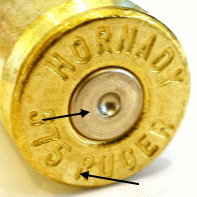
The Ruger round was pretty good at letting me know when pressures were climbing. This is the case from one of two loads that do not appear on the tables. You can see the beginning of a firing pin hole and ejector slot being tattooed on the case head. This was accompanied by a slight sticking of the bolt as the lugs cammed to extract the case from the chamber. No hammers required for bolt pounding to extract. The hot case measured the same as the other fired case population just forward of the extractor groove, 0.5314″, and the shoulder diameter was consistent with the other fired brass at 0.516″. The overall case length, however, was a full 0.007″ longer at 2.585″ than the other checked brass. For a point of reference, new unfired brass measured 0.5303″ above e extractor groove, 0.514″ at the shoulder and 2.575″ in untrimmed overall case length. The highest velocity was not attained with the highest pressures, suggesting the issue of excessive pressure was more a reflection of an inappropriate powder selection than anything else. The case definitely works better with slower case filling powder and there are lots of good choices. None of the loads were compressed, but there was not enough to step up to the next slower powder.
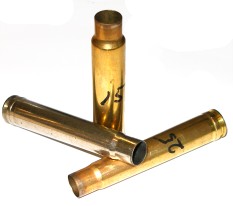 I’m use to picking up once fired 338-378 Weatherby brass and admiring its bell sounding like qualities on my way to annealing them. None of these cases seemed more the worse for wear than a standard cartridge. I suspect they will have a long life ahead of them, saving annealing for the 4th or 5th outing. The 375 H&H cases showed a great degree of dimensional change in comparison to the 375 Ruger after firing. Factory unfired brass measured 0.506 just forward of the belt, the coat hanger shoulders 0.448″, untrimmed length 2.840″. Fired Hornady Heavy Magnum loads went 0.511″, 0.451″ and 2.848″. Federal; 0.511″, 0.473″ and 2.828″. My handloads on new Remington brass went 0.510, 0.452″, 2.837″ which is a direct comparison to the new brass dimensions I noted for the 375 H&H.
I’m use to picking up once fired 338-378 Weatherby brass and admiring its bell sounding like qualities on my way to annealing them. None of these cases seemed more the worse for wear than a standard cartridge. I suspect they will have a long life ahead of them, saving annealing for the 4th or 5th outing. The 375 H&H cases showed a great degree of dimensional change in comparison to the 375 Ruger after firing. Factory unfired brass measured 0.506 just forward of the belt, the coat hanger shoulders 0.448″, untrimmed length 2.840″. Fired Hornady Heavy Magnum loads went 0.511″, 0.451″ and 2.848″. Federal; 0.511″, 0.473″ and 2.828″. My handloads on new Remington brass went 0.510, 0.452″, 2.837″ which is a direct comparison to the new brass dimensions I noted for the 375 H&H.
The good news is the 375 Ruger is not one of those cartridges where handloaders can’t duplicate and, in some cases with careful component selection, exceed factory ammo performance. The 375 H&H I believe is well under loaded in most factory rounds, outside of perhaps the Hornady Heavy Magnum ammunition and some of the Federal High Energy ammo.
General Observations and Conclusions
I’ll keep the Hawkeye African I purchased as a personal firearm and work with the cartridge and rifle combination because it is worth the effort. I hope Ruger and Hornady try to permit and promote this cartridge with other manufacturers. A large installed base will insure the cartridges futures and put ammo on shelves at a large number of locations. I honestly believe I have witnessed a transition in cartridges and firearms. A dangerous game rifle no longer has to be represented by a 10 pound, long barreled magnum length action, outfitted with express sights and hog’s back stock. A dangerous game rifle can now look and feel like a unpretentious deer rifle that would blend in on any gun store rack. The king is dead…you know the rest. It would be foolish for me to suggest that the 375 H&H can no longer accomplish what it has for the past 95 years, or that the 375 Ruger has such a dramatic ballistic advantage over the 375 H&H firearm enthusiasts will dump their current rifles just to get this new cartridge. I would say they may very well head for the nearest Ruger dealer because of the substantial hardware benefits; all that power in a 7 lb something sporter, that doesn’t beat the shooter black and blue and gives away nothing to the 375 H&H is performance. Now we only have to wait for the obvious .338 and .458 versions of this case.
375 H&H Vs 375 Ruger Part I of II
375 H&H Vs 375 Ruger Part II of II
Thanks,
Joe

Email Notification